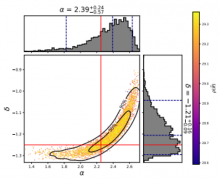
Abstract
The black hole area theorem implies that when two black holes merge, the area of the final black hole should be greater than the sum of the areas of the two original black holes. We examine how this prediction can be tested with gravitational-wave observations of binary black holes. By separately fitting the early inspiral and final ringdown phases, we calculate the posterior distributions for the masses and spins of the two initial and the final black holes. This yields posterior distributions for the change in the area and thus a statistical test of the validity of the area increase law. We illustrate this method with a GW150914-like binary black hole waveform calculated using numerical relativity and detector sensitivities representative of both the first observational run and the design configuration of Advanced LIGO. We find that the area theorem could be confirmed to ∼66% confidence with current sensitivity, improving to ∼97% when Advanced LIGO reaches design sensitivity. An important ingredient in our test is a method of estimating when the post-merger signal is well-fit by a damped sinusoid ringdown waveform.